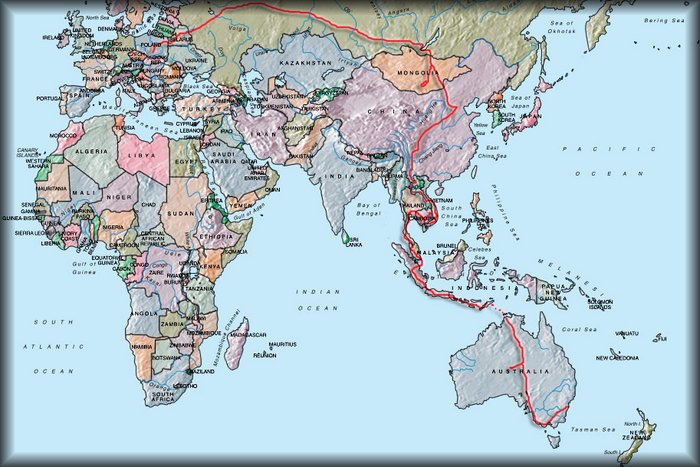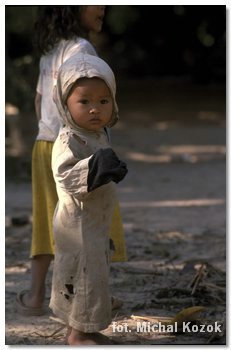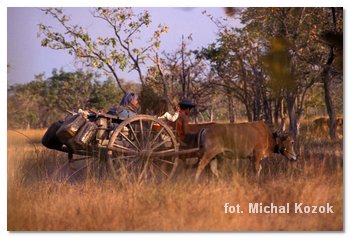
Asia is the largest and most populated continent in the world, has the highest mountain, the greatest depression, the deepest lake, etc. It is not only unusual in geography, but also in history - there is the first settlement and the great civilizations, leaving the proved in the form of temples, palaces, ruins etc. In addition, culture of Persia, India, China, Siberia, Indonesia and Japan are so different from each other, that crossing just one border,we coming in another dimension of reality. And ethnic and religious mixture makes this continent the most varied on our globe. In this diversity everyone will find something what you like. My dream was to get from Poland to Sydney, through Asia, by land and sea only.
trip: Poland – Belarus – Russia – Mongolia – China – Laos - Vietnam – Cambodia – Thailand – Myanmar – Thailand – Malaysia – Singapore – Indonesia – East Timor – Australia
team: I travelled with my three Polish friends until Cambodia, after that I travelled by myself.
period: 16 November 2001 – 6 March 2002 (3.5 months – 111 days)
I moved quickly because my time was restricted by money and visas. I prefer travelling individually, the cheapest way avoiding all the commercial tourist places. You will get to know the people and their life styles much better in one day than if you took a two week holiday organised by a travel agency. So, I used the cheapest public transport and accommodation. I bargained to get the lowest price. As the saying goes: "The more people you meet the more you know the country." As for the tourist attractions that I have wanted to see, I've seen.
Facts: In total I travelled through 15 countries in 111 days, spent 802 hours in transport carriers and covered distance of 34300km, by land 31200km, by boat 2300km, and only 800km in 1.5 hours by plane.
![]()
My Costs
What is very important, especially for students and backpackers, is that it has not been an expensive journey. As a matter of fact one day in Asia (counting from Irkuck to Dili) cost me on average: food 3.5 USD per day, accommodation: 2.2 USD per night, and transport 5.1 USD per day.
Below I've written TOTAL COST of my trip. Prices are in US dollars, the rate in March 2002 was 1 AUD = 0.55 USD or 1 USD = 1.82 AUD.
 a) Cost in Poland, before the trip (except visa permit fees):
a) Cost in Poland, before the trip (except visa permit fees):
Vaccinations: Hepatitis A & B (Engerix B-2 series and Havrix A-1 series) 105 USD; 6-12 months after one more in Australia.
Tablets against malaria: Darapiam (a Polish product) 50 tablets 4.8 USD
Medicines/Vitamins : 10 USD,
Book Guides, Lonely Planet "South-East Asia on shoestring": 23.90 USD
Souvenirs to give a local people : 14 USD
Buying "second hand" winter clothes, which you throw out later : 15.40 USD
Insurance : 40 USD
Travelling to Warsaw to visit consulates : 29.50 USD
Calls: 4.90 USD
Passport Photos: 8.50 USD
Other Cost : 9.40 USD
Total 262 USD
b) Cost during the journey:
I often travelled by night (24 times) and I used the cheapest local transport, similar with accommodation. About food - there is no reason to save any money. Entrance fees, souvenirs, calls, Internet, postcards and other costs are individual depending you on you and availability.
c) Specials costs:
Taking photos: I prefer slides and I used Fuji Sensia 100, 200 or Velvia 50. It is very useful to use tripod and another lens up to 300mm. Experienced advice - if you like something, that is original, specifically for the country or area you are in, take a photo straight away, don't wait for a better moment, you can loose the precious opportunity. I purchased 13 slide films for 65 USD, developing: 34 USD, slide frames (450): 41 USD
Taxes for bank's operations (Visa autod) and a loss of money for while exchanging money cost me about 80 USD.
Total Costs: 2685 USD = 4887 AUD
In conclusion, I would like to point out that it is not too expensive for that kind of journey. Travelling can become a way to life, like in my case. If you like travelling, don't buy a direct air ticket. Stopovers don't cost much, stopover make your trip more interesting. Maybe when you see the true hard life in Asia you'll understand better how lucky you are! Good luck on your travels, enjoy your life and no worries.
![]()

In Buddhist countries avoid touching the head of another person, it is not well accepted. According to their beliefs the head is a temple of the body, feet hold the least regarded position. In practice this means that you should not put feet on a table or chair, do not show the soles, nor indicate anything and anyone by feet.
Women should not come into any contact with the monks, can not stand or sit next to them on the bus, should not give them anything directly or touch their belongs. Islamic countries such as Malaysia and Singapore are as liberal in relation to the Western women's dress fashion, but in the Islamic parts of Indonesia better cover your head, shoulders and knees. A little respect for their culture never hurt. The only catholic countries on my Asian route were Vietnam and East Timor.
Also remember that in many parts of the continent's use of toilet paper is not too common - instead in use is water and left hand. This means that you should do the right hand operations in public (such as consumption of food, giving a money, etc).
Very popular saying in the South-East Asia used to Western tourists is "same same, but different". Many agencies were advertising their services this way, you with a smile ask what exactly is this "difference".
![]()
Visas: before we start the trip we must do some search through embassies. The addresses and telephone numbers are easily found in Yellow Pages or on the Internet. Then we need to get the opening hours of the Visa Department, print the form - fill out and sign it in accordance with the passport signature, and accompanied with photos and money can be applied. The majority of visas and extensions of stay can get on the way, but then, instead of visiting and enjoying the holiday we wasting time for the offices running.
![]()
 Weather - I went to Siberia in November, and this is not the warmest season. Temperatures ranged from 20°C below zero up to 0°C. The further south the warmer, after crossing the Tropic of Cancer I felt significant warmer.
Weather - I went to Siberia in November, and this is not the warmest season. Temperatures ranged from 20°C below zero up to 0°C. The further south the warmer, after crossing the Tropic of Cancer I felt significant warmer.
South-East Asia - is always hot and humid. On the mainland wet season lasts from June to October. Later, the best period without the terrible heat and high humidity (from December to February - the high season) and a very warm and humid period is from March to May.
Malay Peninsula has slightly different periods, the rainy season lasts from May to October on the west coast, but on the opposite side (the east coast) monsoon is from November to February.
On the Indonesian islands is best to get between May and September. Since then the rains begin in Sumatra and gradually move to the east, hitting the Timor around November/December.